September 2nd, 2009 · 1 Comment
Author’s Note: This post was written and live by yesterday at 2:45 PM. Due to systems maintenance back at Dickinson where the servers are, it was mysteriously deleted and all traces ceased to exist on the Internet. Fortunately I managed to find a partial backup of the post with Firefox’s super clutch about:cache utility. Panic attack over.
Okay, so I was the only one who opted out of going to the backstage tour of the National Theatre. Bad call Andrew, bad call. So while I depressively sit in my room waiting for the group to return, I might as well write one big über-post reflecting on the last week or so here in Britain.
To go back a few days, after Stonehenge, we schlepped out to Bath. I experienced some major mixed fellings on the way there. A knowledgeable friend told me that if there is one place to see in the UK, it is Bath. However, it’s a city whose economy is completely reliant on tourism, and I hate tourist traps. The city itself is a sight to be seen. The architecture stands out most clearly, as almost every building within the city limits is built in the Georgian style of the 18th and 19th Centuries.

http://en.wikipedia.org/wiki/Bath,_Somerset
The first landmark we encountered was Bath Abbey, a picturesque Gothic cathedral from the 7th Century. I stood outside and stared at the exterior for a good ten minutes before entering. It is enchanting, imposing, captivating, and just about any other adjective of the sore fathomable. With that in mind, I was thrilled to go inside. The interior was the mixed feelings I had earlier incarnate. The nave itself is gorgeous, featuring high, vaulted ceilings and intricate stained glass windows reminiscent of Westminster. Juxtaposing the ancient architecture, however, were LCD monitors, postcard stands, and any other touristy accoutrement you can imagine. That made me physically sick to the stomach. It is one thing to have a gift shop attached to historical sites, as long as they are distinctly separated. There is nothing wrong with a tourism economy. But just as the Church and the State should be mutually exclusive, so should the site and the shop. A message to the tourism bureau of Bath: NEVER SHIT WHERE YOU EAT. It is not only offensive to the historical purity of the building, but downright sacrilegious to so blatantly mix shopping with as place as important as Bath abbey.
On a related note, The Tower of London wasn’t any better. Maybe we just chose the worst possible time to visit, but it was absolutely stuffed to the gills with sightseers. We forewent seeing the illustrious crown jewels because the queue was longer than the line for Splash Mountain in Disney World. And I’m sure the main attraction isn’t nearly as exciting. To be entirely honest, I didn’t learn much during my time at the Tower. I know that it is very rich historically, serving as a fortress, a prison, a headquarters, and most recently, a kitschy tourist trap. The most best aspect were the enormous ravens hanging out all over the grounds. They made entertaining noises. Not worth the money. (I took the following photographs.)


CAWWW!
Phew. Ranting is cathartic.
Also, I am attempting to embed a slideshow of Bath Abbey into this post, but am failing miserably. I am giving up and posting a link to a slide.com slideshow instead. Click here to view.
Moving on, yesterday was the world famous Notting Hill Carnival, the second largest street festival on the planet. To give the reader a perspective, imagine a crowded rock concert, complete with all the four essential, ubiquitous smells: food, beer, body odor, and ganja. Now take that crowd and spread it out over a twenty square mile radius, but don’t bother thinning out the population density. This year’s attendance figures aren’t live yet, but in past years the event has attracted an upwards of 1.5 million people split over two days, most on Monday, the main event. Since everything else is closed due to the national bank holiday, about an eighth of London’s population has nothing better to do, so why not get a taste of Afro-Caribbean culture and go to Carnival? (When reading, make sure to roll the R in Carnival for dramatic effect). Everywhere I went was in earshot of calypso, reggae, soca, or any other Caribbean-centric music played at rock concert decibel levels. There were more jerk chicken booths than Starbucks in Manhattan. Red Stripe and Corona quenched the throats of everyone, from the lavishly dressed parade people to the pasty white 20-somethings who can’t dance, in attendance just to escape the vanilla routine of Western life (i.e. me). It is definitely worth seeing, but make sure you arrive in the afternoon. We made the mistake of getting there at 10 AM, and were bored for about two hours.
Slideshow attempt #2
On a completely unrelated note, I have been listening to a lot of jazz lately, namely good hard-bop from the early 70s. I listen to a lot of music and it is by far one of my favorite genres, especially when seen live. As a result, I’ve been craving some raw, live jazz, and what better place to experience it than in the cultural center of the UK. I’ve also been considering writing my research paper on the London jazz scene, so it’s probably a good idea to get out there and experience it first hand. My rabid Googling has pointed me to a place called the 606 Club (click the link to see where the club got it’s name). The reviews are pretty glamorous (“London’s best music venue”), so I’m very excited to go in for a cocktail and listen to some great improvisational jazz, or whatever they have playing that evening. If you have never seen good jazz played in person, trust me on this one and come along to see the show. It is truly the best kind of live music around. Skilled musicians can emanate such powerful emotion from their horns, basses, drums, or voices unheard of in rock, hip-hop, or anything else kids today listen to. Definitely worth the £10 or so cover.
That about does it for now. I’m gonna get back to drinking wine alone in my underwear.
Tags: Andrew B
Although they all act as places of rest for the public, the parks of London all seem to have unique identities, stemming from where they are geographically. Take St. James park for instance: Located between the Prime Minister’s house and Buckingham Palace, the park highlights elaborate flower formations and the vast amount of birds that live in the pond that runs through the park. Because of the high volume of tourists that are running through the park, a sizeable cafe is located right in the middle of it all, offering overpriced espressos and a view of the ducks for all that are interested. In turn, all of the paths lead in the park point right to tourist attractions, like the Churchill Museum, Buckingham Palace, and Westminster Abbey.
Regent’s Park on the other hand is much more low-key. Surrounded completely by houses, the park acts more as an area for relaxation than a way to direct foot-traffic. With long and circular paths, the park is a great area for both exercise and recreation. While there is a cafe in the park, it is small in size and offers more reasonably priced food and drink.
Even more inconspicuous are the numerous parks around the Bloomsbury area. The same concept as Regent’s Park but on a smaller scale, most of the parks just have sitting areas surrounded by a single path. Those parks that special will even have a plaque or two to famous figures.
It is staggering to think how something so simple as a park can be transformed to fit the specific needs of the area it is in. However, given the fact that London survives on the tourist dollar, it should come as no surprise that something as simple as a park would be transformed to streamline the tourist industry.
Tags: Paul
Recently the Dickinson gang (including those Sciences weirdoes) took a trip to the picturesque town of Bath. Originally a resort town for the nobles of England, the town has thankfully spread out to let us mere mortals in. Situated between two hills with a river running through the center of town, it all seems too good to be true, and in a way is. The commercial center of the town is filled with shops of all variety, from stores like Tesco and Boots, to expensive boutique stores. Additionally, the town market was centered towards serving functional goods rather than souvenirs. After all of the obvious tourist traps in London, I was admittedly a little miffed at not being able to find too many places to criticize (That being said, it was pretty inexcusable to charge 1 pound just to enter the park. I guess I’m just spoiled from the fee-less parks of London… and everywhere else). Of course there were things like the street performers and tourist spots like the Roman Baths, but after hiking to the top of one of the hills through a purely residential area, all of that seemed to slip away. Perhaps this is the actual aim of Bath, to make it a place of recognition but at the same time be able to exist outside of its tourist identity (If only most parts of London could take a note).
Tags: Paul
There are a total of eight Royal Parks within all greater London: St. James’s Park; The Green Park; Hyde Park; Kensington Gardens; Richmond Park; Greenwich Park; The Regent’s Park and Bushy Park. Thus far, I have visited three of these: St. James’s Park; Greenwich Park and The Regent’s Park. Each park was very different, yet shared a similar history.
St. James’s Park, originally created by King Henry VIII as a personal deer park for hunting, is located in Westminster. The park has been remodeled several times, including once for King Charles II in the 1600’s and again in the first half of the 1800’s by John Nash. The closest tube stops include Piccadilly Circus, Charing Cross and, of course, St. James’s Park.
This park is absolutely massive. You could easily spend an entire day here. Perhaps the most interesting feature of this park is its wildlife. There were waterfowl of all kinds paddling and preening in around the long lake that stretches through the park and placards along the way that discussed each species. The asphalt walkways circling the lake contain markers that indicate that the Princess Diana Memorial Walk trails through the park. With all the flora and fauna found inside St. James’s Park, it only seems appropriate to commemorate one of Great Britain’s most beloved members of the royal family here, amidst such beauty.
St. James’s Park is a popular spot for tourists and locals alike. There were many families, especially, snapping pictures of the scenery, but also native Brits jogging or enjoying lunch or a book in the park. What I did find interesting was that there were very few non-whites in the park. I remember seeing one tourist family of what appeared to be an Indian descent inside the park, posing for family snapshots by a knotty tree, and a two black women with strollers and little, skipping girls around the age of five, who walked along the sidewalk on the outskirts of the park, but never entered it.
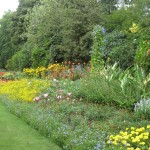


Greenwich Park is equally interesting. We walked through this park on our way to The Royal Observatory, which is located almost in the center of the park. The Observatory was commissioned by King Charles II (see hyperlink above) in 1675 and was designed by Christopher Wren, the architect who was responsible for countless famous buildings around London including St. Paul’s Cathedral and others circa the Great Fire of 1666. The park is inaccessible via the tube, but many buses such as the 188 and 53 run through Greenwich at frequent intervals.
This park, which is divided by the Prime Meridian features much more open space than either St. James’s or The Regent’s Park. There are large expanses of lawns – slightly browning in areas – with trees dotting the landscape throughout, but no fences, hedges, walls or other structures that create intimate spaces within the park. As we walked through the park I noticed many families and couples strolling through the park, and several joggers. There was a friendly yet rather skinny dog sniffing around the sneakers of several students. He carried a ball in his mouth and seemed to plead with his icy blue eyes for a playmate. He wandered around without direction and I wondered if he was blind, or homeless, and watched the ribs shift under his taut skin.
The abandoned dog, the slightly sunburned grass and the lack of flora cast a feeling of melancholy upon me as I walked through the park. I didn’t feel joy or peace in Greenwich Park as I did in St. James’s or The Regent’s Parks. Even the view of the city from the top of the hill upon which the observatory is situated depressed me. It is a view full of skyscrapers, power plants, power lines, smoke stacks no longer in use. When I am in the city for too long, I crave green space, but in Greenwich Park, I found myself preferring the city.
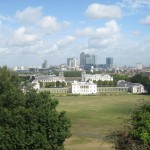
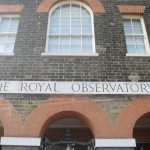
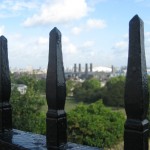
The Regent’s Park, located between Paddington and Camden Town, is accessible via several tube stops, including; Marylebone, Great Portland Street and, of course, Regent’s Park. The park was originally another of King Henry VIII’s deer gardens (see hyperlink above) and features the Queen Mary’s Garden, an area of the park blooming with over nine thousand begonias.
The Regent’s Park is one of the most stunning places, if not the most, I have been lucky enough to visit in my life. The walkways reach out through rows of shaped cylinders of shrubbery and tall hedges line the walkway, creating walls of green that flank beds of bright flora. Fountains pour out clear water that glints in the sun, cascading like icicles ripped from rooftops in the winter. There are areas reserved strictly for children, areas with cafes, an outdoor amphitheatre and a community sports and recreation centre. The overall feeling that I had being in the park was one of peace and serenity. Car horns, sirens, the pounding of joggers’ feet and the wails of children with scraped knees or simply a poor temperament could not be heard in the near silence of the park. For one who is quick to grow weary of the London hustle-bustle, The Regent’s Park serves as the quintessential getaway.
All of the Royal Parks I have visited thus far each have their own distinguishing characteristics, and a unique essence. But don’t take it from me. Hope on the tube and go find yourself some green.
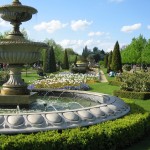
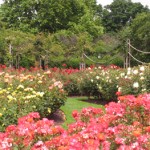
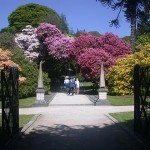
Tags: Anya
Let me preface all of this by saying that I am, as my fellow classmates have stated, incredibly grateful for the opportunity to see both Stonehedge and Bath– two great world heritage sites. Both trips were incredible and photograph-worthy (believe me, I took enough pictures for the entire year that day). I, however, do not share my classmates’ adoration of the city of Bath. I doubt a person exists in the world who doesn’t find the city to be one of beauty. That being said, a city built to cater to tourists is one that does not rank on my list of favorite places in the world. I recognize that I am a tourist so begrudging a city for catering to me sounds a bit odd. Truly though I would rather visit a place to appreciate what it has to offer rather than it intentionally enticing me to visit it by being built around what it thinks I might like.
At the Roman Baths themselves, I found myself most attracted to the Bill Bryson audio option on the audio tour. An author of many travel books, he was well-equipped to take me around the Roman Baths in an educational and still humorous manner. He made a comment at one of the corners that if you looked around you would see how much the site has been altered since the Romans bathed there. Following his advice, I looked around. I saw a water fountain out of which you could drink the very water that the Romans bathed in for a low, low price of fifty pence. I saw a newly remodeled bathroom that was made to look like an authentic Roman bathroom equipped with automatic sinks and hand driers. I saw outside of the baths street performers that were both incredibly talented and incredibly good at attracting large amounts of people. I then realized that I was listening to Bill Bryson. Let’s pause. Listening to him was a great way to get through the museum. But Bill Bryson? Such a recognizable name guarantees that the museum is authentic. Right? Maybe the museum was even it was being invaded by the idea of catering to the tourist while still trying to make a pound or two from the endeavor.
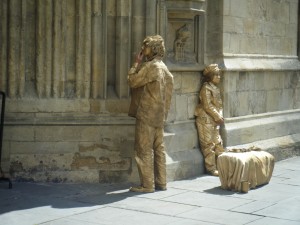
Street performers in Bath
Upon leaving the museum, a fellow student and I decided to try to capture the beauty of the city (because, truly, being built for tourists does have its perks when it comes to the overall visual beauty of the city). Deciding that the top of the hill would bring the best result for such a photo opportunity, we began our ascent. Two hours later, we realized that we were not the only one’s who thought the top of the hill was the best way to view the city. All of the residences were placed up there with beautiful views…and walls surrounding their homes to shield nosy tourists away from enjoying those views. The tourists, it seems, were to stay in the valley where they should be content to watch the street performers, shop around in cutesy boutiques, and listen to the soothing voice of Bill Bryson. I have nothing against such things! But it seems to me that if a tourist is willing to venture away from those confines and really get to know the place that is Bath, they should be able to. If a tourist wants to see and experience the landscape that the city sits upon, the true foundation of the city, they should be able to. It seems that those that profit from keeping the tourists down in the valley have other ideas. Our differences aside, the other student and I were able to get the shot (after two hours of searching). We had to climb up on a wall and duck under a few tree branches to get it, but we were successful nonetheless. When a woman who was walking her dog saw us, she rolled her eyes in a way that suggested she knew our kind all too well. “Tourists” she seemed to sigh. And as she continued to walk by, I was for once happy to have that label to hide behind as reason for my seemingly odd behavior.
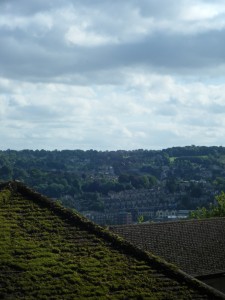
Only one of many picture taken from 'the view'
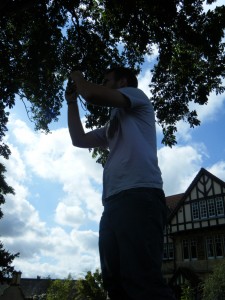
The dedication required to view Bath correctly
Just a side note: the following is a link to the criteria for a world heritage site. It’s just interesting to ponder in relation to what the city of Bath has become. List of criteria for World Heritage Sites
Tags: Audrey
Within the past three days I have visited The Tower of London, Stonehenge, the Roman Baths, and the Globe. Visiting these tourist traps has made me realize that in one respect I actually agree with A. N. Wilson, the author of London: A History, I think that the Disney-fication of these places has drastically transformed and even destroyed their historical significance.
When visiting Bath in particular I had trouble grasping that I was actually looking at the real Roman Baths. Not only is this hard for me to fathom this because I have never laid my eyes on something so old, but I also felt that the way they were presented made the idea of their authenticity completely unimaginable. I fold that the amalgam of the old with the new, the numerous signs, and tourists confused me and made it difficult to decipher the authentic from the fake.
I enjoyed every place that I have visited but I feel that attaching a gift shop to a place like Bath and the Tower of London makes them lose all possible historical value, and makes the places feel like an amusement park. After Stonehenge and the Tower of London I was left feeling a sense of unfulfillable and wanting more, almost as though I had missed something.
In fact, I have had a hard time grasping the fact that I am in England at all. The only time that I really started to comprehend that I am actually in England was when we driving through the countryside on our way to Bath. Unlike Stonehenge, the Tower, and the Globe I found this strangely refreshing and honest. There were no tourists snapping a million pictures, fences, snobby people in suits, or signs telling you which buttons to press on your listening device. For me that was England, not the double decker buses nor the red telephone booths with porn pasted on the inside. I am loving London but am anxious to settle in at UEA.

The Jewel House at the Tower of London
Tags: Rebecca
August 22nd, 2009 · 1 Comment

Outisde the Apple Market
Although it has only been two days, we were beginning to become a little skeptical of A.N. Wilson’s portrayal of a London overrun by American corporations and solely meant for tourism. All of the places that were not already tourist attractions were certainly un-American, and the cuisine was not only worldly but also a surprising amount of fusion food available (Indian/Japanese anyone?). However, after visiting the Covent Garden Market, we caught a glimpse of the England that was made for the tourist. The market is best described as a market for those who want to buy foreign things, but not too foreign. In the Jubilee Market, the shops almost entirely consisted of souvenir and novelty stalls.

A Keychain Shop
People visiting were welcomed to buy everything from London t-shirts, to calendars of David Beckham, and even London-themed condoms (“Want to see Big Ben?”). For those who didn’t have the local currency, there were numerous exchange agents and even stores that accepted American dollars and Euros.
The Apple Market was located in a 12th century abbey where the local monks would grow and sell their vegetables. Keeping in the tradition, there were a variety of chain stores, t-shirt vendors and cafes (The one fruit stand was not even located in the market, but outside one of the entrances).
Of the two markets, Apple seemed to consist more of permanent establishments, however Apple Market’s aim was no different from Jubilee in its desire to attract foreigners, with a welcome sign in several different languages, albeit slightly higher quality.
The surrounding neighborhood also played towards the same theme of tourism, with only the most popular chain retailers lining the streets such as Gap, The Disney Store, Starbucks, H&M, and others. The local theaters were mostly playing shows that had previously or were still on Broadway. Across from the market was the St. Paul’s Church but it was unfortunately closed at the time we were there.

St. Paul's Church
Slightly disillusioned by the cookie-cutter appeal of the Covent Garden area, we decided to walk back to the hotel. It took fifteen minutes of walking until the number of major chain retailers began to decrease and we began to see independent businesses (and pubs!).
The market clearly recognized that this was the type of London that tourists both expected and wanted to see. The shops were easily recognizable, the streets were clean, the vendor made sure that you knew that what you were buying was foreign, and everyone was white.

American Fare
Tags: Markets · Paul · Rebecca · Sarah





















